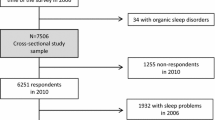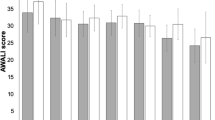Abstract
Background: Demands from work and home may interfere with one another and the stress engendered by that can be detrimental to health. Purpose: To study the relationship between experienced interference and subjective health, and address the impact of unwinding on these associations. Method: Questionnaire data from a representative sample of the Swedish population are used considering full-time and part-time employed women and men aged 25–64. The associations between negative interference (either work-home or home-work) and sleep quality, self-rated health, and the use of sleeping pills/tranquillizers are analyzed by means of logistic regressions, compiling odds ratios (ORs) with 95% confidence intervals (CIs). The impact of adjustment for lack of unwinding on these associations is assessed. Results: Work-home interference is associated with suboptimal sleep quality and self-rated health for both women and men. The significance of this disappears among women after adjustment for lack of unwinding, regardless of work schedule. Among both sexes, home-work interference is associated with suboptimal sleep quality and self-rated health. When adjusting for lack of unwinding, the relationship to sleep quality disappears, but not the one to self-rated health, equally for women and men. Conclusion: Only among women, unwinding seems to buffer the association between work-home interference and health.
Similar content being viewed by others
References
Åkerstedt, T., Ingre, M., & Eriksen, C. (2003).Work hour flexibility and the ability to sustain working life to retirement. (No. 308, Stress Research Reports). Stockholm: Institute of Psychosocial Medicine and Karolinska Institutet.
Åkerstedt, T., Kecklund, G., Gillberg, M., Lowden, A., & Axelsson, J. (2000). Sleepiness and days of recovery.Transportation Research Part F: Traffic Psychology and Behaviour, 3(4), 251–261.
Åkerstedt, T., Knutsson, A., Westerholm, P., Theorell, T., Alfredsson, L., & Kecklund, G. (2002). Sleep disturbances, work stress and work hours: A cross-sectional study.Journal of Psychosomatic Research, 53(3), 741–748.
Barnett, R. C., Gareis, K. C., & Brennan, R. T. (1999). Fit as a mediator of the relationship between work hours and burnout.Journal of Occupational Health Psychology, 4(4), 307–317.
Bellavia, G., & Frone, M. R. (2004). Work-family conflict. In K. Barling & M. R. Frone (Eds.),Handbook of work stress (pp. 113- 147). Thousand Oaks, CA: Sage.
Byron, K. (2005). A meta-analytic review of work-family conflict and its antecedents.Journal of Vocational Behavior, 67(2), 169- 198.
de Croon, E. M., Sluiter, J. K., & Frings Dresen, M. H. W. (2003). Need for recovery after work predicts sickness absence: A 2- year prospective cohort study in truck drivers.Journal of Psychosomatic Research, 55(4), 331–339.
Demerouti, E., Bakker, A. B., & Bulters, A. J. (2004). The loss spiral of work pressure, work-home interference and exhaustion: Reciprocal relations in a three-wave study.Journal of Vocational Behavior, 64(1), 131–149.
Elwood, P., Hack, M., Pickering, J., Hughes, J., & Gallacher, J. (2006). Sleep disturbance, stroke, and heart disease events: Evidence from the Caerphilly cohort.Journal of Epidemiology & Community Health, 60(1), 69–73.
Emslie, C., Hunt, K., & Macintyre, S. (2004). Gender, work-home conflict, and morbidity amongst white-collar bank employees in the United Kingdom.International Journal of Behavioral Medicine, 11(3), 127–134.
Frankenhaeuser, M., Lundberg, U., Fredrikson, M., & Melin, B. (1989). Stress on and off the job as related to sex and occupational status in white-collar workers.Journal of Organizational Behavior, 10(4), 321–346.
Frone, M. R. (2000). Work-family conflict and employee psychiatric disorders: The National Comorbidity Survey.Journal of Applied Psychology, 85 (6), 888–895.
Geurts, S. (2003). Work/non-work interface: A review of theories and findings. In M. Schabracq, C. L. Cooper, & J. A. M. Winnubst (Eds.),The handbook of work and health psychology (pp. 279–312). New York: J. Wiley.
Geurts, S., Taris, T. W., Kompier, M. A. J., Dikkers, J. S. E., van Hooff, M. L. M., & Kinnunen, U. M. (2005). Work-home interaction from a work psychological perspective: Development and validation of a new questionnaire, the SWING.Work & Stress, 19 (4), 319–339.
Hallsten, L., Josephson, M., & Torgen, M. (2005).Performance based self-esteem: A driving force in burnout processes and assessment. (No. 2005:5, Arbete och halsa). Stockholm: National Institute for Working Life.
Higgins, C., Duxbury, L., & Johnson, K. (2000). Part-time work for women: Does it really help balance work and family?Human Resource Management, 39(1), 17–32.
Higgins, C., Duxbury, L., & Johnson, K. (2004).Exploring the link between work-life conflict and demands on Canada’s health care system. (No. 3, National study on balancing work, family and lifestyle). Ottawa: Health Canada.
Jansen, N., Kant, I., Kristensen, T. S., & Nijhuis, F. J. (2003a). Antecedents and consequences of work-family conflict: a prospective cohort study.Journal of Occupational and Environmental Medicine, 45 (5), 479–491.
Jansen, N., Kant, I., van Amelsvoort, L., Nijhuis, F., & van den Brandt, P. (2003b). Need for recovery from work: Evaluating short-term effects of working hours, patterns and schedules.Ergonomics, 46(7), 664–680.
Kinnunen, U., & Mauno, S. (1998). Antecedents and outcomes of work-family conflict among employed women and men in Finland.Human Relations, 51(2), 157–177.
Kohn, M. L., Miller, J., & Schooler, C. (1983).Work and personality: An inquiry into the impact of social stratification. Norwood, NJ: Ablex.
Krantz, G., Berntsson, L., & Lundberg, U. (2005). Total workload, work stress and perceived symptoms in Swedish male and female white-collar employees.European Journal of Public Health, 15(2), 209–214.
Lindfors, P., Berntsson, L., & Lundberg, U. (2006). Total workload asrelated to psychological well-being and symptoms in full-time employed female and male white-collar workers.International Journal of Behavioral Medicine, 13(2), 131–137.
Lundberg, U. (1996). Influence of paid and unpaid work on psy- chophysiological stress responses of men and women.Journal of Occupational Health Psychology, 1(2), 117–130.
Major, V. S., Klein, K. J., & Ehrhart, M. G. (2002). Work time, work interference with family, and psychological distress.Journal of Applied Psychology, 87(3), 427–436.
Manderbacka, K. (1998). Examining what self-rated health question is understood to mean by respondents.Scandinavian Journal Social Medicine, 26(2), 145–153.
McEwen, B. S. (2001). From molecules to mind: Stress, individual differences, and the social environment. In A. R. Damasio (Ed.),Unity of knowledge: The convergence of natural and hu man science (pp. 42–49). New York: New York Academy of Sciences.
Melin, B., Lundberg, U., Soderlund, J., & Granqvist, M. (1999). Psychological and physiological stress reactions of male and female assembly workers: A comparison between two different forms of work organization.Journal of Organizational Behavior, 20(1), 47–61.
Morehead, A. (2001). Synchronizing time for work and family: Preliminary insights from qualitative research with mothers.Journal of Sociology, 37(4), 355–369.
Rook, J. W., & Zijlstra, F. R. H. (2006). The contribution of various types of activities to recovery.European Journal of Work and Organizational Psychology, 15(2), 218–240.
Singh-Manoux, A., Martikainen, P., Ferrie, J., Zins, M., Marmot, M., & Goldberg, M. (2006). What does self rated health measure? Results from the British Whitehall II and French Gazel cohort studies.Journal of Epidemiology & Community Health, 60(4), 364–372.
Sluiter, J. K., de Croon, E. M., Meijman, T. F., & Frings-Dresen, M. H. (2003). Need for recovery from work related fatigue and its role in the development and prediction of subjective health complaints.Occupational and Environmental Medicine, 60, (Suppl. 1), 62–70.
Sonnentag, S., & Kruel, U. (2006). Psychological detachment from work during off-job time: The role of job stressors, job involvement, and recovery-related self-efficacy.European Journal of Work and Organizational Psychology, 15(2), 197–217.
Theorell, T. (2006). New directions for psychosocial work environment research.Scandinavian Journal of Public Health, 34, 113–115.
Theorell, T., & Hasselhorn, H. M. (2005). On cross-sectional questionnaire studies of relationships between psychosocial conditions at work and health—are they reliable?International Archives of Occupational and Environmental Health, 78, 517- 522.
Torgén, M., Stenlund, C., Ahlberg, G., & Marklund, S. (2001).A sustainable work life for all ages [in Swedish]. Stockholm: National Institute for Working Life.
Torkelson, E., & Muhonen, T. (2004). The role of gender and job level in coping with occupational stress.Work & Stress, 18(3), 267–274.
Väänänen, A., Kevin, M. V., Ala Mursula, L., Pentti, J., Kivimäki, M., & Vahtera, J. (2004). The double burden of and negative spillover between paid and domestic work: Associations with health among men and women.Women and Health, 40(3), 1- 18.
van Rijswijk, K., Bekker, M. H. J., Rutte, C. G., & Croon, M. A. (2004). The relationships among part-time work, work-family interference, and well-being.Journal of Occupational Health Psychology. 9 (4, 286–295.
Author information
Authors and Affiliations
Corresponding author
Rights and permissions
About this article
Cite this article
Nylén, L., Melin, B. & Laflamme, L. Interference between work and outside-work demands relative to health: unwinding possibilities among full-time and part-time employees. Int. J. Behav. Med. 14, 229–236 (2007). https://doi.org/10.1007/BF03002997
Issue Date:
DOI: https://doi.org/10.1007/BF03002997




